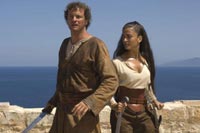They say there’s a kernel of fact behind every legend, and every now and then a film comes along that tries to pull back the curtain on a popular tale by imagining what might have “really” happened way back when. Several years ago, The 13th Warrior suggested the Beowulf stories were inspired by an encounter between Vikings and a mysterious tribe in northern Europe. More recently, King Arthur re-cast the famed English king as a Roman military officer who stuck around in the British Isles.
The Last Legion continues in that tradition by pushing Arthurian legend even further back into Roman history—but as with all these speculative tales, the fact that the legends have been dressed up in historical garb does not make the new stories any less bogus. In fact, if anything, the historical details become a distraction.

Take the opening narration, which tells us that a special sword (can you guess which one?) was acquired by the Roman dictator Julius Caesar and inherited by “the last of his line,” the Emperor Tiberius. It’s not entirely clear what this means, since Tiberius—who was adopted by Augustus, who in turn was adopted by Julius Caesar—was actually the second of five emperors in that dynasty. So how was Tiberius “the last of his line” if he was neither a genetic descendant nor the last ruler in that family?
Things get even more pointlessly erroneous when the story proper begins. A subtitle tells us the story is set in Rome in A.D. 460, but it revolves around a boy named Romulus Augustus (Thomas Sangster) who most historians regard as the last of the Roman emperors—and who, in fact, was actually elevated to the emperor’s throne, while still a young teen, in A.D. 475. (Incidentally, the capital city of the Western Roman Empire at this point was no longer Rome, but had been a city called Ravenna for several decades.)
And there are much bigger anachronisms. An evil masked tyrant in Britannia named Vortgyn (Harry Van Gorkum) lives in a splendidly huge castle that could not have existed before the medieval era, while the Romans go about their affairs as though they still lived in the first century. With the possible exception of a tiny cross on the emperor’s crown, there is not a hint of the fact that the bulk of the Empire had converted to Christianity over a century before. Instead, Romulus is told at his coronation that he is joining “the immortals,” and he openly wonders if he is now “a god or a boy.”

Perhaps I am nit-picking, but movies that lay claim to some sort of historical basis do invite this kind of scrutiny—and truth be told, part of the fun of watching junky would-be epics such as The Last Legion is coming home to an encyclopedia or search engine afterwards and looking up what the movie got right and what it didn’t.
The blatant errors wouldn’t be so bad, though, if movies like these at least had some of the entertainment value that we associate with the legends that supposedly inspired these films. As it is, The Last Legion follows an obvious Arthurian template, but without capturing any of the magic of an actual Arthurian folk tale.
Romulus is the boy who would be king, and in fact, when we first see him, before his coronation, he is mistaken for a street thief by Aurelius (Colin Firth), a soldier who has just returned to Rome after several years away and is unfamiliar with the current royal family. In this, we have a dim, distant echo of the stories in which the young Arthur served as a knight’s humble squire before his royalty was revealed.

There is also a Merlin figure in Ambrosinus (Ben Kingsley), a “philosopher” who acts as the boy’s mentor and performs a few magic tricks—though he doesn’t do anything that can’t be explained away as the work of good reflexes, sleight-of-hand and theatrical staging. It is striking, actually, how the film keeps reminding us that Ambrosinus is an illusionist who merely tricks people into thinking that he has supernatural powers. If we can’t take him seriously as a Gandalf-like wizard—if, indeed, we have been shown that he is adept at deceiving people—then why should we believe anything that he might have to say about “destiny” and the like?
Not long after the young Romulus is crowned emperor, Rome is attacked by the Goths, whose brutish, hairy, fur-clad leader Odoacer (Peter Mullan) promptly claims the throne for himself. (One of the more amusing things about The Last Legion is how the main Roman characters are played by Englishmen—or Englishboys, in Sangster’s case—while the main Gothic barbarians are played by Scotsmen.)
Various imprisonments, rescues, betrayals and fights ensue before Aurelius—now a member of the imperial guard, charged with protecting the emperor—decides that the safest course of action for Romulus and those few guards who remain loyal to him would be to leave Italy, trek all the way across Europe, sail the English Channel, and then trek some more, until they arrive at Hadrian’s Wall … which is way up north near the border between England and Scotland. Apparently there are no reinforcements closer to home, but the Romans do have some troops way out on the Empire’s frontier; they are “the last legion” to which the movie’s title refers.

Danger follows in the form of Odoacer’s lieutenant Wulfila (Kevin McKidd), who has a special grudge against Romulus and pursues the boy’s entourage all the way to Britannia. Alliances are formed, battles are waged, and much of the action surrounds a certain mysterious sword that Romulus picked up when he was still in Italy.
For a historical battle epic, The Last Legion is surprisingly bloodless, though it is not for lack of action scenes—many of which involve an empowered female warrior named Mira (Bollywood superstar Aishwarya Rai) who comes from India by way of Constantinople and decides to help Romulus and his crew after her masters turn against them. Details like these give the film the feel of a TV-movie—so it comes as no surprise to discover that this is director Doug Lefler’s first feature film, or that his résumé includes stints on the Hercules and Xena: Warrior Princess TV shows.
(Incidentally, Mira, of course, strikes up a sort of reluctant romance with Aurelius—it’s one of those relationships where swordfights take the place of dinner and a movie—and it is kind of amusing to see Firth, the star of the 1995 BBC miniseries Pride & Prejudice, become entangled with Rai, who starred in the Bollywood musical adaptation Bride & Prejudice.)
Eventually, though, you wonder what all the fight scenes add up to. What exactly is the message or theme of this movie? Aurelius gives a speech before the climactic battle in which Rome supposedy embodies all that is free and all that is opposed to tyranny—and it rings hollow. Young Romulus, meanwhile, is never more regal than in the moments after he has finally killed a man in cold blood—and what sort of signal does that send? “We all need heroes,” says Ambrosinus, but why? Where are they? What do they represent? This movie, for all its quasi-realism, is never as inspiring, interesting, or disturbing as the stories to which it points.
Talk About It
Discussion starters- “We all need heroes,” says Ambrosinus. Is this true? What sort of heroes do you have? How does the Bible treat its own heroes?
- Why do you think people might want to know what “really” happened when they hear a myth or legend? What is more important, the legend or the reality that lies behind it? Does it depend on the context in which the story is told? Explain.
- How would you respond if someone pointed to a story in the Bible and said he wanted to know what had “really” happened there. Would your answer depend on which particular Bible story he was pointing to? Why or why not?
- What do you make of Ambrosinus and the “magic” he performs? Why do you think he performs those illusions, even during battle? Do you find it easier or harder to take anything he says seriously, knowing that his “magic” is a sham?
- Ambrosinus tells Romulus that “every living creature has a destiny, be sure of it.” Do you agree? Where does “destiny” come from? Does it allow for free will?
The Family Corner
For parents to considerThe Last Legion is rated PG-13 for sequences of intense action violence, including stabbings and spearings and cold-blooded killings by heroes and villains alike and at least one scene where a man’s finger is cut off—though almost all of these wounds are inflicted off-camera. The villainous Vortgyn brands a symbol onto the young Ambrosinus’s chest which depicts the sword Excalbur inside a pentagram; the older Ambrosinus describes this pattern as the Britons’ “symbol of faith and truth.”
Photos © Copyright the Weinstein Co.
Copyright © 2007 Christianity Today. Click for reprint information.












